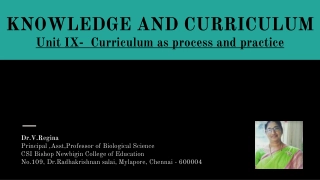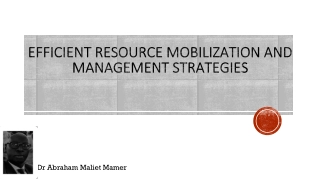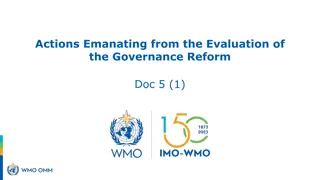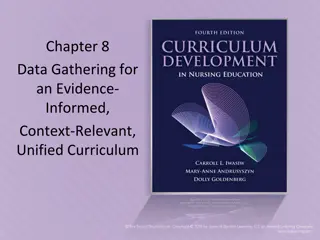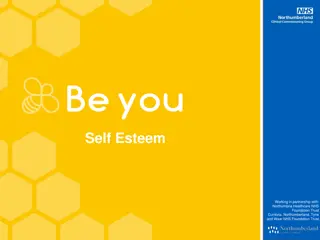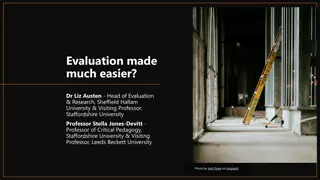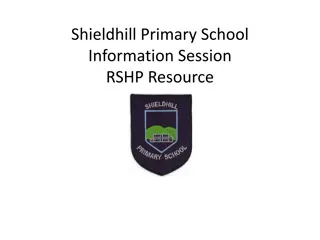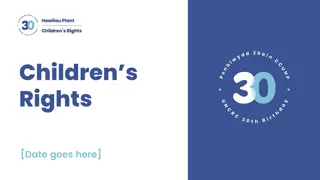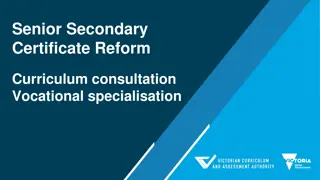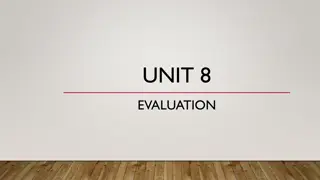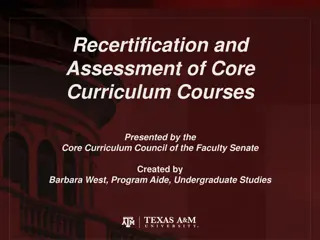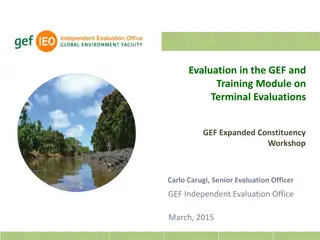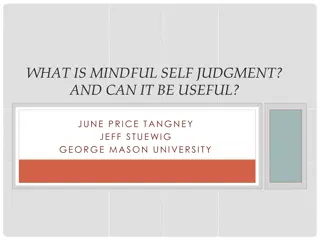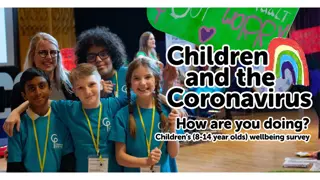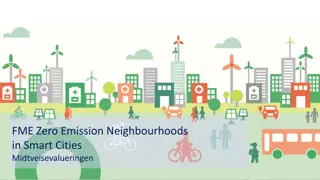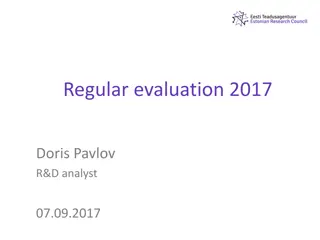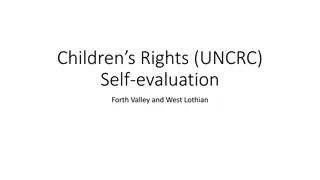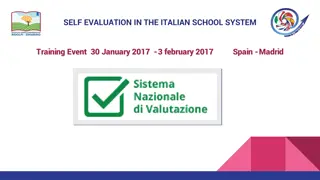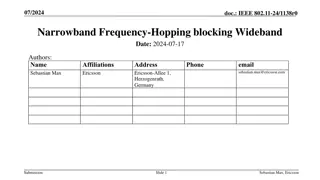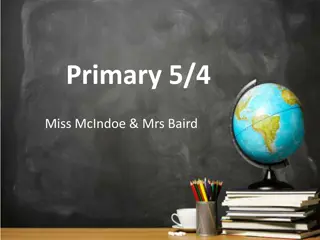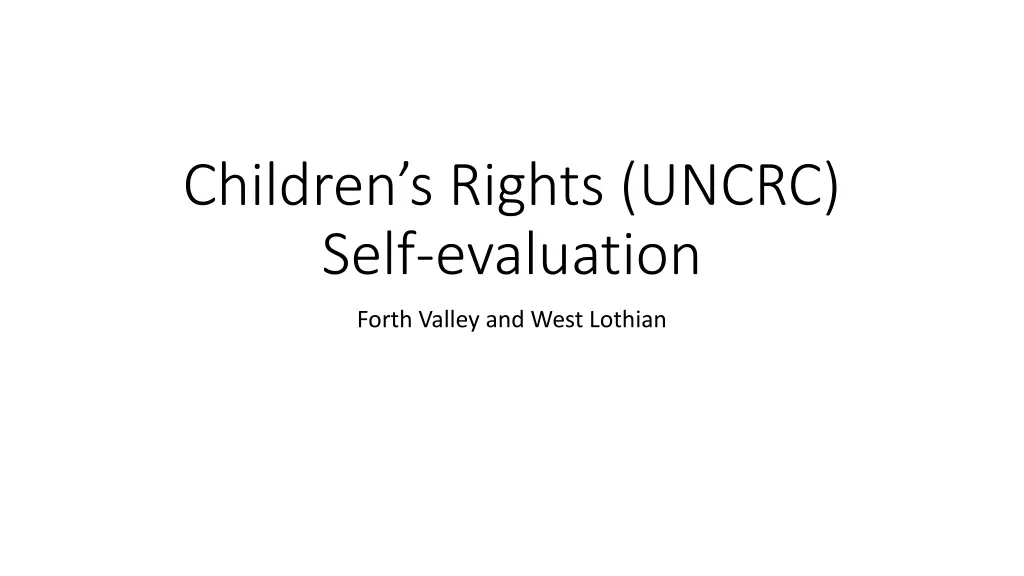
Understanding the Incorporation of UNCRC into Scots Law
Explore the implications of incorporating UNCRC into Scots law for educational settings, with evaluative statements, examples, and guidance on practice. Learn how to recognize and realize children's rights within the curriculum.
Download Presentation

Please find below an Image/Link to download the presentation.
The content on the website is provided AS IS for your information and personal use only. It may not be sold, licensed, or shared on other websites without obtaining consent from the author. If you encounter any issues during the download, it is possible that the publisher has removed the file from their server.
You are allowed to download the files provided on this website for personal or commercial use, subject to the condition that they are used lawfully. All files are the property of their respective owners.
The content on the website is provided AS IS for your information and personal use only. It may not be sold, licensed, or shared on other websites without obtaining consent from the author.
E N D
Presentation Transcript
Childrens Rights (UNCRC) Self-evaluation Forth Valley and West Lothian
Introduction UNCRC is set to be incorporated into Scots law This has implications for educational settings It is important that education settings are prepared for this incorporation by understanding what it means and how it will affect practice This resource is designed to support this understanding by providing: - evaluative statements - examples of what this looks like in practice - prompts to RAG each statement
Format/guidance on the use of this resource The following slides are adapted from the self evaluation document on Education Scotland s National Improvement hub page: Recognising and realising children s rights (see notes for link) The format is as follows: - 5 sections, each with around 5 evaluative statements - Evaluative statement and some ideas to consider - Discussion prompts to RAG the evaluative statement - What could RAG look like? (please note these are suggestions and are by no means exhaustive) - At the end of each section signposts to resources/training and examples of practice This can be used at in-service or staff meetings, to be discussed in small groups. You may wish to start with a different section that is most relevant to your setting A Microsoft Form has been created to enter and collate responses to the evaluative statements (see notes section) This is designed as a tool to be used in an ongoing way rather than as a whole powerpoint in one go.
Section 4: Links to the curriculum Contents: Contents: a) We know where the UNCRC articles are naturally taught within the curriculum b) Relevant articles are highlighted in planning, teaching and learning c) Relevant articles are highlighted in displays of children s young people s work/progress d) We explore and reference articles through opportunities for wider achievement e) We explore and reference articles through opportunities to engage with local, national and international community partners f) We explore and reference articles through assemblies Click to navigate to the relevant statement
Section 4: Links to curriculum a) We know where the a) We know where the UNCRC naturally taught within the curriculum naturally taught within the curriculum UNCRC articles are articles are Some ideas to consider Audit and map where UNCRC articles naturally correlate to the curricular areas Identify important gaps in teaching about rights and plan to cover these across the year/contexts for learning Departments/stage-partners meet to review curriculum in light of articles Discussion prompts: How well can we articulate where the UNCRC articles are naturally taught within the curriculum? How do we know? What evidence do we have? What else do we need to do? Back to Section 4 contents
What could red/amber/green look like? Red = not part of current practice Amber = ongoing development Green = consistent practice A few pupils/ members of staff can identify where rights are taught in the curriculum Less than half of pupils/ members of staff can identify where rights are taught in the curriculum . All or almost all pupils/ members of staff can identify where rights are taught in the curriculum It has been identified which UNCRC articles naturally fit with which curricular areas Gaps in coverage of the articles are identified Departments or stage partners make plans/ changes to curriculum made to cover the gaps ADD YOUR MICROSOFT FORM LINK HERE IF USING Now agree a rating for the above statement Back to Section 4 contents
Notes to capture discussions/evidence Add your evidence here Back to Section 4 contents
Section 4: Links to curriculum b) Relevant articles are highlighted in planning, b) Relevant articles are highlighted in planning, teaching and learning teaching and learning Some ideas to consider Pilot the development, planning and teaching of curricular planners and teaching approaches which make the links to relevant articles explicit Involve children and young people in making decisions about delivery, methodology and planning of learning, teaching and assessment Discussion prompts: How well do we highlight relevant articles in planning learning and teaching? How do we know? What evidence do we have? What else do we need to do? Back to Section 4 contents
What could red/amber/green look like? Red = not part of current practice Amber = ongoing development Green = consistent practice A few plans and lessons make explicit reference to relevant articles, learners are sometimes involved in planning Less than half of plans and lessons make explicit reference to relevant articles, learners are often involved in planning All or almost all plans and lessons make explicit reference to relevant articles, learners are always involved in planning Teaching plans and learning and teaching make explicit reference to relevant articles Young people are involved in the planning of learning and teaching ADD YOUR MICROSOFT FORM LINK HERE IF USING Now agree a rating for the above statement Back to Section 4 contents
Notes to capture discussions/evidence Add your evidence here Back to Section 4 contents
Section 4: Links to curriculum c) Relevant articles are highlighted in displays of c) Relevant articles are highlighted in displays of children s young people s work/progress children s young people s work/progress Some ideas to consider Plan displays of work and explicitly highlight links to any relevant UNCRC articles Discussion prompts: How well do we highlight relevant articles young people s work/progress? How do we know? What evidence do we have? What else do we need to do? Back to Section 4 contents
What could red/amber/green look like? Red = not part of current practice Amber = ongoing development Green = consistent practice A few displays of work/progress highlight relevant articles Less than half of displays of work/progress highlight relevant articles. All or almost all displays of work/progress highlight relevant articles Displays of work / displays of progress are planned to make links to relevant UNCRC articles (e.g. pupil profiles, or wall displays) Relevant articles are displayed next to pieces of work/ noticeboards of achievements etc. ADD YOUR MICROSOFT FORM LINK HERE IF USING Now agree a rating for the above statement Back to Section 4 contents
Signposts to further training/resources: Section 4: Links to curriculum Connecting children s rights to CfE (Children s Parliament) Curricular and lesson resources: - Early years Amnesty Resources - Children's Parliament (childrensparliament.org.uk) Primary and secondary lesson resources Children s Comissioner Scotland Primary teacher resources (Children s Commissioner Wales) Secondary teaching resources (Children s Commissioner Wales) a) We know where the UNCRC articles are naturally taught within the curriculum b) Relevant articles are highlighted in planning, teaching and learning c) Relevant articles are highlighted in displays of children s young people s work/progress Back to Section 4 contents
Section 4: Links to curriculum Examples of practice: Coming soon not yet complete see Home The Inspiration Hub a) We know where the UNCRC articles are naturally taught within the curriculum b) Relevant articles are highlighted in planning, teaching and learning c) Relevant articles are highlighted in displays of children s young people s work/progress Back to Section 4 contents
Section 4: Links to curriculum d) We explore and reference articles through d) We explore and reference articles through opportunities for wider achievement opportunities for wider achievement Some ideas to consider Produce an outline of wider achievement opportunities that are available within the school and the local community; make explicit links to relevant articles and skills for life, learning and work Discussion prompts: How well do we explore and references articles through opportunities for wider achievement? How do we know? What evidence do we have? What else do we need to do? Back to Section 4 contents
What could red/amber/green look like? Red = not part of current practice Amber = ongoing development Green = consistent practice A few opportunities for wider achievement highlight relevant articles Less than half opportunities for wider achievement highlight relevant articles. All or almost all opportunities for wider achievement highlight relevant articles Those running opportunities for wider achievement reference UNCRC articles in the planning UNCRC articles are referenced when children and young people engage in the opportunity for wider achievement ADD YOUR MICROSOFT FORM LINK HERE IF USING Now agree a rating for the above statement Back to Section 4 contents
Section 4: Links to curriculum e) We explore and reference articles through opportunities to engage with local, national and international community partners Some ideas to consider Produce an outline of wider achievement opportunities that are available within the school and the local community; make explicit links to relevant articles and skills for life, learning and work Discussion prompts: How well do we explore and references articles through opportunities to engage with local, national and international community partners? How do we know? What evidence do we have? What else do we need to do? Back to Section 4 contents
What could red/amber/green look like? Red = not part of current practice Amber = ongoing development Green = consistent practice A few opportunities for engaging with partners highlight relevant articles Less than half opportunities for engaging with partners highlight relevant articles. All or almost all opportunities for engaging with partners highlight relevant articles Those running opportunities for engaging with partners consider and reference UNCRC articles in the planning UNCRC articles are referenced when children and young people engage in the opportunity to engage with partners ADD YOUR MICROSOFT FORM LINK HERE IF USING Now agree a rating for the above statement Back to Section 4 contents
Signposts to further training/resources: Section 4: Links to curriculum Resources for children and young people -Advice for children (Children s Commissioner Scotland) -Advice for young people (Children s Commissioner Scotland) -Resources for children and young people (Children s Commissioner Wales) d) We explore and reference articles through opportunities for wider achievement e) We explore and reference articles through opportunities to engage with local, national and international community partners Back to Section 4 contents
Section 4: Links to curriculum Examples of practice: Coming soon not yet complete see Home The Inspiration Hub d) We explore and reference articles through opportunities for wider achievement e) We explore and reference articles through opportunities to engage with local, national and international community partners Back to Section 4 contents
Section 4: Links to curriculum f) We explore and reference articles through assemblies Some ideas to consider Produce a calendar of assembly reflections for the year, each with a specific focus on certain articles; e.g. article of the month ; Discussion prompts: How well do we explore and reference articles in assemblies? How do we know? What evidence do we have? What else do we need to do? Back to Section 4 contents
What could red/amber/green look like? Red = not part of current practice Amber = ongoing development Green = consistent practice A few assemblies throughout the year highlight relevant articles Less than half assemblies throughout the year highlight relevant articles. All or almost all assemblies throughout the year highlight relevant articles A clear plan for references UNCRC articles in assemblies is articulated Anyone involved in delivering assemblies is aware of the plan ADD YOUR MICROSOFT FORM LINK HERE IF USING Now agree a rating for the above statement Back to Section 4 contents
Signposts to further training/resources: Section 4: Links to curriculum f) We explore and reference articles through assemblies for wider achievement Children's commissioner for Wales - Right of the month Human rights calendar Back to Section 4 contents
Section 4: Links to curriculum Examples of practice: Coming soon not yet complete see Home The Inspiration Hub f) We explore and reference articles through assemblies for wider achievement Back to Section 4 contents

